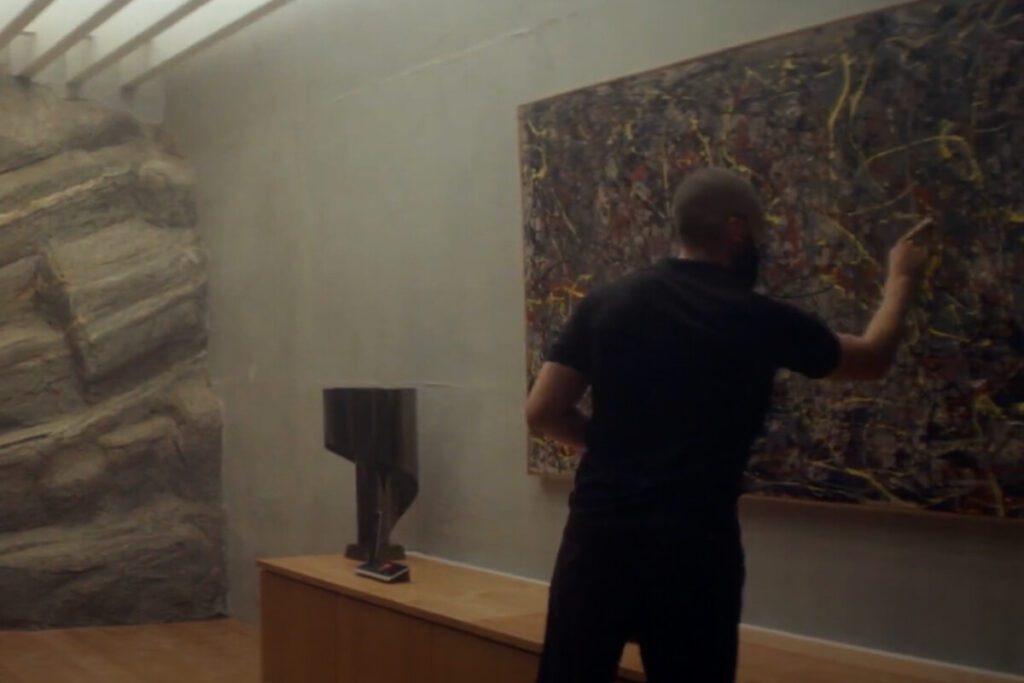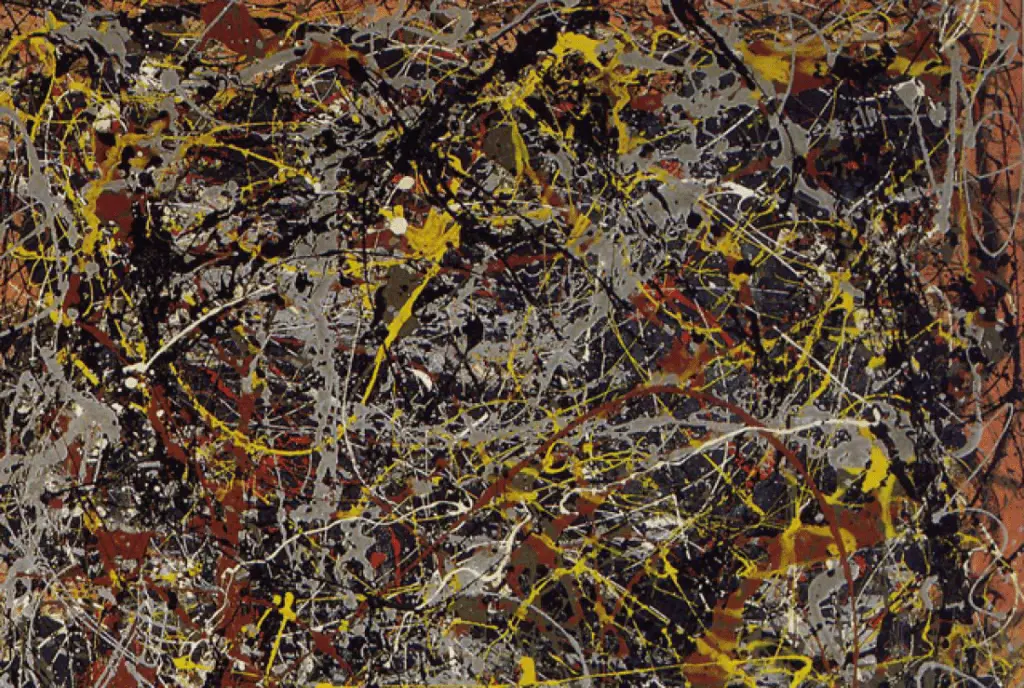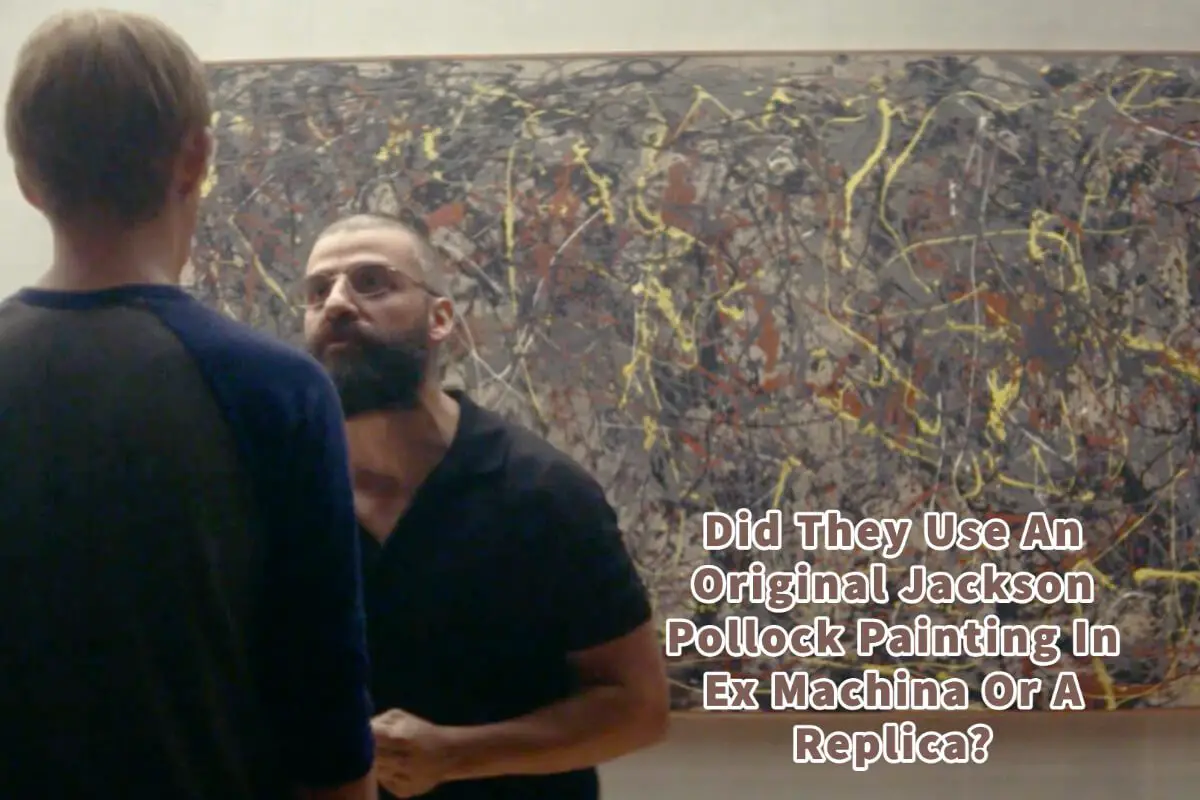Jackson Pollock’s paintings are famous and used in many films; a Jackson Pollock painting can be seen in the film Ex Machina (2014)
The film Ex Machina would have used a copy of the Jackson Pollock painting No 5 (1948); the painting was sold by David Geffen, a Hollywood producer and film studio executive, for over USD 140 million in 2006. Geffen would have sold the painting long before the movie was produced, and no respectable art collector would place such a valuable work of art on a film set or studio.
Table of Contents
- Ex Machina (2014) – Jackson Pollock No 5 (1948) – Film Would Have Used Replica
- About Jackson Pollocks No 5, 1948
- Frequently Asked Questions
- Related Questions
Ex Machina (2014) – Jackson Pollock No 5 (1948) – Film Would Have Used Replica

The Jackson Pollock painting No. 5 (1948) used in the movie Ex Machina (2014) would have been a replica. The reason is that this painting had already been sold in 2006 for a considerable sum of money.
Facts About Jackson Pollock No, 5 (1948)
Here are some facts about Jackson Pollock No. 5 (1948) and why the one used on the movie set would have been a replica or reproduction:
- Painting Is Worth Over 140 Million Dollars – Jackson Pollock’s painting No 5, 1948, sold in 2006 for $140 million. David Geffen sold it in a private sale. The painting fetched a record price. In 2014 the painting would have been worth more than that amount.
- The Worth Of The Painting Is Way Over The Entire Movie Budget – The Ex Machina movie budget was only $15 million, and the painting was worth ten times that amount in 2013 (over $140 million); no one would put an original painting of that value on a movie set.
- Insurance Would Not Insure It On A Movie Set – A valuable painting is usually an investment so that it would be insured. Insurers would not insure it for it to be on a movie set under camera lights and used as a movie prop.
- The Painting Was Only A Prop – The No 5, 1948 by Jackson Pollock was only a prop in the movie and was not crucial for the movie’s success. There is no reason for them to risk the painting getting stolen or destroyed on the movie set. Even though the painting was an important object lesson, there would be no need to use the original.
- No Collector Would Expose Their Collection Like This – No serious art collector, or someone who paid so much money for a single painting would expose their investment in such a way. If the painting becomes damaged, it could destroy the investment.
- Painting Is Valuable Due To Provenance – Many Pollock paintings have not been able to be verified as being Jackson Pollock. One of the essential aspects of No 5, 1948, is that the painting is known to have impeccable provenance. All the previous owners of the painting are known and have verified this is an original Jackson Pollock. No one would risk the provenance of the painting being put in doubt due to the original hanging on a movie set.
For all these reasons, and maybe many others, including using the original artwork would not make financial sense or the risk associated with it for a movie prop, the No 5 1948 in the movie Ex Machina would have been a replica of Jackson Pollock’s original painting.
About Jackson Pollocks No 5, 1948

Jackson Pollock’s painting No. 5, 1948, was created on a fiberboard measuring 8” by 4”, so it is a large painting. In this painting, Pollock chose to use liquid paints; more specifically, they were enamel paints, even though the work is classified as oil paints.
He used the colors grey, brown, white, and yellow paint drizzled so that many people consider it a very dense bird nest.
Alfonso A. Ossorio originally purchased the painting and composition from Pollock at a show at the Betty Parson Gallery in 1949; it was the only painting sold at the show.
When Ossorio’s partner showed paint he purchased, he was known to say:
“You spent money on that?”
Ted Dragon, Ossorio’s partner
At some point, the painting was damaged during the moving process. Pollock was told to quickly patch up the painting before it was delivered, hoping Ossorio would not notice the patched-up paint job.
But Ossorio did notice the defect and told Pollock he needed to repair the damage. Pollock took the painting back to his studio. Instead of fixing the painting, it is said that he completely repainted it to a work now considered far superior to the original painting.
Ossorio, in speaking of the painting and how the repaint improved the painting he originally purchased, as of the rework of No 5, 1948:
“A wonderful example of an artist having a second chance.”
Alfonso A. Ossorio
Jackson Pollock’s painting of No 5, 1948, is an excellent example of how valuable his paintings have become. From the original, sold in 1949 for 1,500 USD, to the painting today, in 2006, it sold for 140 million dollars. It shows how important Jackson Pollock and his work have become to art collectors worldwide.
There would be no need to use the original for such a valuable and iconic painting to be part of a movie. The movie producers would have used a painting replica or copy as part of their movie props. The painting is far more valuable than even the entire budget spent on the movie.
Anita Louise Art is dedicated to art education, great artists, and inspiring others to find and create their art. We love art that uplifts and inspires. #ArtToMakeYouSmile! #ArtToMakeYouHappy!
If you are interested to see any of my art, you can find out more by clicking here. If you are interested in what inspires me and my paintings, you can discover more by clicking here.
We have a free newsletter and would love you to be part of our community; you can subscribe to the newsletter by clicking here. If you have any questions, I would be happy to talk to you. You can reach me, Anita, by clicking here.
Subscribe to our Anita Louise Art YouTube Channel with great videos and information by clicking here.
Join us for our podcast “5 Minutes With Art.” Spend just 5 minutes a week with us to discover and learn about great art and artists. You can find out more about our podcast by clicking here.
Frequently Asked Questions
Did the filmmakers use an original Jackson Pollock painting in Ex Machina?
No, the filmmakers used a replica of a Jackson Pollock painting in Ex Machina.
Which specific Jackson Pollock painting is featured in the film?
The painting featured in the film is believed to be a replica of Jackson Pollock’s No 5 (1948).
Was the original Jackson Pollock painting used in Ex Machina ever owned by David Geffen?
Yes, the original painting, No 5 (1948), was owned by David Geffen before being sold for over USD 140 million in 2006.
Was David Geffen still the owner of the painting when Ex Machina was produced?
No, David Geffen had sold the painting long before the production of Ex Machina, and it was in the possession of a new owner.
Why wouldn’t a respectable art collector place such a valuable work of art on a film set or studio?
Art collectors typically avoid exposing valuable works of art to the potential risks and hazards associated with film production, making the use of replicas more practical.
Who created the replica of the Jackson Pollock painting for Ex Machina?
The specific artist or studio responsible for creating the replica used in Ex Machina may not be publicly disclosed, but prop and set designers are typically involved in such tasks.
How accurate was the replica compared to the original Jackson Pollock painting?
The accuracy of the replica would depend on the skill and attention to detail of the artist or studio creating it, but filmmakers generally strive for a high level of accuracy when reproducing iconic artworks.
Was the use of the Jackson Pollock painting in Ex Machina authorized by the owner or estate of the artist?
Filmmakers typically seek permissions or licenses for the use of copyrighted artworks in their films. It’s likely that the necessary permissions were obtained for the use of the Jackson Pollock replica.
Are replicas commonly used in films for valuable artworks?
Yes, replicas are commonly used in films to protect valuable artworks from potential damage or loss during the production process.
Is the replica used in Ex Machina considered a collectible or valuable in its own right?
The replica itself may not hold the same value as an original Jackson Pollock painting, but it could have significance as a film prop or memorabilia for collectors interested in movie history.
Related Questions
How Much Is The Jackson Pollock Painting Worth In The Movie “The Accountant”?
We do not know precisely how much the Jackson Pollock Free Form painting is worth, but we know that it is owned by the Museum of Modern Art in New York City, and the painting in the movie The Accountant is a reproduction or copy. We know that similar Jackson Pollock paintings have sold for over $100 million. So we know that Jackson Pollock’s paintings are precious in today’s art market.
What Makes Jackson Pollock’s Art So Valuable?
Jackson Pollock was a brilliant and creative artist who was not afraid to try new techniques with art. He is known for being a founder of Abstract Expressionism and the gestural technique, also known as action painting. He never saw much success in his lifetime, but today his painting fetch millions of dollars and are considered extremely valuable.
By clicking here, you can discover more by reading What Makes Jackson Pollock’s Art So Valuable?.
Understanding Jackson Pollock’s Paintings And His Art
Understanding that Jackson Pollock has absolute honesty in his paintings, he shows us his great technique and ability to use paint in ways that have never been used before. His paintings are very dimensional, so when you look at them in one way but get up close, you may see another way. He’s not trying to fool us in any way but just saying here, view it as you want to see it.
By clicking here, you can learn more by reading Understanding Jackson Pollock’s Paintings And His Art.


